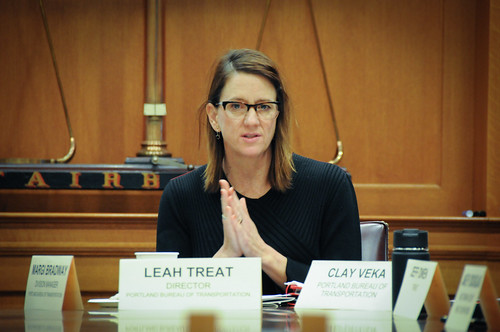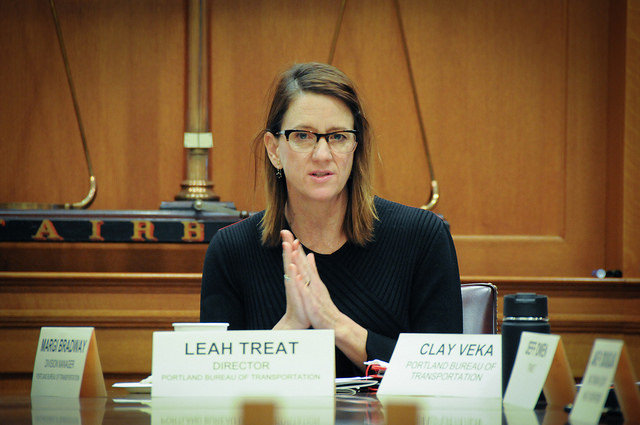
(Photo: J. Maus/BikePortland)
When a city says traffic safety is their top priority, it should be willing to do whatever it takes to make people drive more slowly.
In Portland that means taking a very close look at the Oregon Revised Statutes.
Portland Bureau of Transportation Director Leah Treat announced today that her bureau will seek permission to enact section nine of ORS 810.180 which gives the city the power to set an “emergency speed” without going through the often onerous process of asking for permission from the State of Oregon. (Note: Another section of this same law gives cities the power to reduce speeds on certain residential streets, thanks to a lobbying effort by PBOT in 2011.)
Treat said they’ve decided to take this very rare step in order to keep people safer on outer Southeast Division Street. Back in December two people were killed while trying to walk crossing Division Street in two separate crashes just hours apart. The tragedies sparked outrage from local residents, activists and even top PBOT staff. One day after the deaths, PBOT Active Transportation Group Manager Margi Bradway called neighborhood leaders to talk about the city’s response. Those conversations led to the passage of $300,000 in emergency funding to do outreach and education in adjacent neighborhoods (which are populated by many people of Chinese and other descents who don’t read or speak English).
To continue their focus on taming Division Street, Treat said PBOT will bring an ordinance to Portland City Council on March 2nd asking them to support the move. The existing state law gives PBOT the ability to make this move, but we’ve never heard of it actually being done.
Here’s the text of the law PBOT will use to reduce the speed limit on outer Southeast Division from 35 to 30 mph:
(9) A road authority may establish an emergency speed on any highway under the jurisdiction of the road authority that is different from the existing speed on the highway. The authority granted under this subsection is subject to all of the following:
(a) A speed established under this subsection is effective when appropriate signs giving notice thereof are posted upon the highway or portion of highway where the emergency speed is imposed. All signs posted under this subsection must comply with ORS 810.200 (Uniform standards for traffic control devices).
(b) The expense of posting any sign under this subsection shall be borne by the road authority having jurisdiction over the highway or portion of highway where the emergency speed is imposed.
(c) A speed established under this subsection may be effective for not more than 120 days.
Advertisement
If Council votes yes (which is very likely, given recent interest and votes on Vision Zero and road safety issues), the lower speed limits would go into effect the following day.
Note that as per the ORS, the emergency can only last up to 120 days. By that time PBOT hopes their official request with the Oregon Speed Zone Review Panel (the ODOT body that controls speed limits on every road in the state) will have already been granted and the speed can remain at 30 mph permanently.
The only wrinkle will be whether or not someone on City Council — or opposition voices that might spring up — can argue against the change by saying an “emergency” doesn’t exist. If that happens, PBOT should have an easy case to make. Myit Oo and Rongzhao Zhang, the two elderly men killed in December, were the fourth and fifth people to die while using outer Division last year alone. In addition to those five fatalities, there were three serious injury crashes on the street in 2016, including one that led to life-threatening injuries and another that led to traumatic injuries. Seven of those collisions happened on a two-mile stretch of Division between 124th and 156th.
PBOT’s plan will be welcome news to transportation reform activists. Volunteers from BikeLoudPDX have advocated for use of this law for over a year now. As early as June 2015 it was cited on their email list and it came up again in December as the group planned a demonstration event that temporarily took over two lanes on Division with protestors and hay bales.
Going beyond just new signs and speed limits, PBOT also has a major capital investment planned for outer Division (east of 82nd) that will break ground this year. The project includes speed cameras, new sidewalks, upgraded crossings, buffered bike lanes, more street lighting, removal of a slip lane, and more.
This is just one more front in PBOT’s war against our speeding epidemic. The agency knows that fewer people will die and become injured if people drive more slowly. In addition to this emergency ordinance, the agency is supporting bills in the legislature this session that will give them even greater control of speed limits (HB 2682) and that would permit them to issue a speeding ticket to someone caught on red light cameras (SB 482/HB 2409).
Stay tuned for a follow-up when the ordinance language is drafted.
— Jonathan Maus: (503) 706-8804, @jonathan_maus on Twitter and jonathan@bikeportland.org
BikePortland is supported by the community (that means you!). Please become a subscriber or make a donation today.


